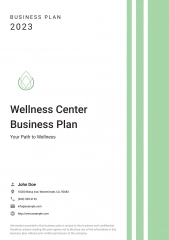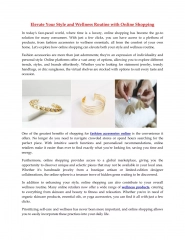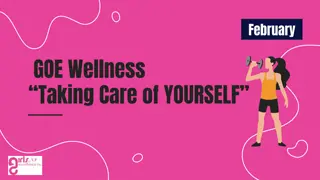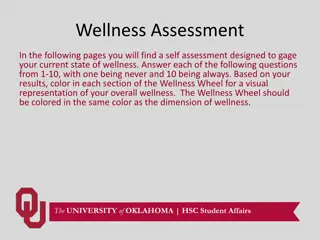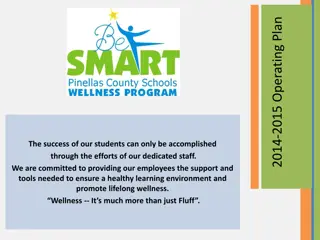
Incorporating Wellness into Course Design by Jessica Danielson
Explore the concept of wellness, its distinctions from well-being and happiness, and the Wellness Wheel model to incorporate holistic health strategies into educational courses designed by Jessica Danielson, PhD. Learn how intentional actions and activities contribute to multidimensional wellness, and examine the interdependent dimensions of the Wellness Wheel to enhance personal and community well-being.
Download Presentation

Please find below an Image/Link to download the presentation.
The content on the website is provided AS IS for your information and personal use only. It may not be sold, licensed, or shared on other websites without obtaining consent from the author. If you encounter any issues during the download, it is possible that the publisher has removed the file from their server.
You are allowed to download the files provided on this website for personal or commercial use, subject to the condition that they are used lawfully. All files are the property of their respective owners.
The content on the website is provided AS IS for your information and personal use only. It may not be sold, licensed, or shared on other websites without obtaining consent from the author.
E N D
Presentation Transcript
Incorporating Wellness in Course Design Jessica Danielson, PhD, LPCC-S, NCC School of Education Counselor Education
Objectives Define wellness Summarize the similarities and differences between wellness and wellbeing Discuss the Wellness Wheel Explore ways to incorporate wellness into courses
What comes to mind when you think of wellness?
What is wellness? The Global Wellness Institute defines wellness as the active pursuit of activities, choices, and lifestyles that lead to a state of holistic health Wellness is.... NOT passive or static about active intentions holistic it encompasses multiple dimensions of life (multidimensional) an individual journey Commonly confused terms: health, well-being, happiness
Whats the difference? Wellness Well-being & Happiness Intention, action, and activities Perception of a state of being Prominent physical dimension Prominent mental/emotional dimension Associated with healthy lifestyle and choices Associated with feelings of satisfaction and sense of fulfillment Can be utilized in measuring individual or community opportunities Is primarily utilized in measuring individual welfare
Wellness Wheel (Dimensions) An interdependent model developed by Sweeney and Witmer Originally had 12 dimensions Physical: recognizes the need for regular physical activity and learning about diet and nutrition Mental/Intellectual/Psychological: recognizes one s creative and stimulating mental activities Emotional: recognizes awareness and acceptance of one s feelings Spiritual: recognizes our search for meaning and purpose in life Social: encourages contributing to one s environment and community and emphasizes interdependence between others and our communities Environmental: recognizes how our environment **Additional dimensional models add occupational which recognizes personal satisfaction and enrichment in on es life through work
Assessing Wellness: Examples A Wellbeing Assessment Tool: https://wmich.edu/eup- instructional/WellbeingAssessment/ Personal Assessment: 8 Dimensions of Wellness: https://www.colorado.edu/health/sites/default/files/attached- files/personal_assessment_-_8_dimensions_of_wellness.pdf Self-Care Assessment Worksheet: https://www.mentoring.org/wp- content/uploads/2020/03/MARCH_2015_Self_Care_Assessment.pdf Self-Care Assessment: https://www.therapistaid.com/worksheets/self-care- assessment.pdf
Ways to Incorporate Wellness in Courses In The Syllabus: Include available student resources that support wellness (e.g., counseling center, wellness center, welltrack app) and highlight them in class Include a statement on wellness Assignments that focus on wellness (e.g., create a wellness plan for the semester, reflection paper that focuses on a topic of wellness) In-Class Ideas: Include wellness presentations or trainings in class Start class will a brief check-in or discussion about wellness or a mindfulness/deep breathing/self-care exercise For longer classes, take breaks and focus on wellness (e.g., stretch, listen to music) Address real world issues and events including on campus, in the community, nationally, and globally Be a role model own your own wellness journey and practices Outside Class Ideas: Flexible homework submissions (e.g., writing, videos, creative projects) Adjust deadlines to promote better sleep hygiene (e.g., instead of midnight, 10:00p) Consider extra credit or make-up points for attending health/wellness events on campus
Discussion How do you practice wellness in your daily life? How have you included wellness in your course design? What barriers or challenges have there been to incorporating wellness in your courses or talking with students about wellness? What resources have you found helpful to navigate wellness with students? What is one takeaway from the time we have shared together?
NDSU Resources Well Track App (for students, staff, and faculty) Multicultural Programs Native American Professional Programs (NAPP) Academic Collegiate Enhancement (ACE) Tutoring Residence Life Career and Advising Center Student Health Service Center for Writers Student Success Programs Counseling Center TRIO Programs Disability Services Wallman Wellness Center International Student and Study Abroad Services Catalog of NDSU Resources: https://catalog.ndsu.edu/student-resources-policies/
References Coleman, M. (2022). 5 Ways College Instructors Can Help Students Take Care of Their Mental Health. HigherEdJobs. Retrieved from: https://www.higheredjobs.com/Articles/articleDisplay.cfm?ID=2992&Title=5%20Ways%20College% 20Instructors%20Can%20Help%20Students%20Take%20Care%20of%20Their%20Mental%20Health Global Wellness Institute (2021). What is wellness? Retrieved from: https://globalwellnessinstitute.org/what-is-wellness/ Hettler, B (1976). Six dimensions of wellness model. National Wellness Institute, Inc. Retrieved from: https://cdn.ymaws.com/members.nationalwellness.org/resource/resmgr/pdfs/sixdimensionsfact sheet.pdf?_ga=2.28164158.324406314.1629998810-146917816.1629998810 Iowa State University Student Health and Wellness (2022). Supporting Student Wellbeing Toolkit. Retrieved from: https://www.studentwellness.iastate.edu/supporting-student-wellbeing-toolkit/ Myers, J. E., & Sweeney, T. J. (2004). The indivisible self: An evidence-based model of wellness. Journal of Individual Psychology, 60(3), 234-245.

